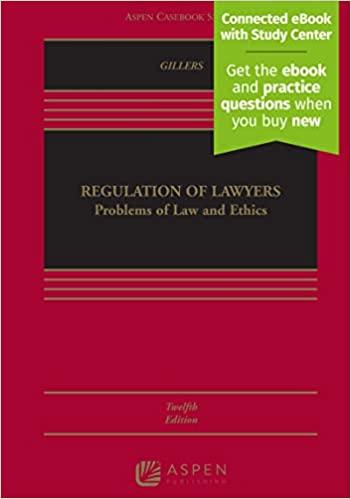Answered step by step
Verified Expert Solution
Question
1 Approved Answer
CASE: M.P. Moller, Inc. v. Wilson. 8C.2d 31 (1936) CASE SUMMARY: (Mr. Ferguson purchases a one-ton pipe organ for his house. The store owner (the
CASE: M.P. Moller, Inc. v. Wilson. 8C.2d 31 (1936) CASE SUMMARY: (Mr. Ferguson purchases a one-ton pipe organ for his house. The store owner (the plaintiff) sold the musical instrument under a conditional sales contract. Under the Agreement, Ferguson took possession of the organ an installed it in his home, but the plaintiff retained title until the instrument was fully paid. Ferguson then defaulted on both the organ payments and his mortgage payments. Ferguson's home was foreclosed, and the defendant purchased the home at the foreclosure sale. The defendant, as the new owner, claimed he owned the organ, because it was a fixture and therefore part of the Real Estate. The plaintiff stated that the organ remained personal property and therefore under the conditional sales contract, he retained title to it. The case arose before the new 1981 statutes covering such disputes.) THE COURT: The only question, therefore, is whether the organ was real or personal property. If the former, in the absence of actual or constructive notice of the plaintiff's rights, it passed to the defendant upon the purchase of the residence. If, on the other hand, it retained its character as personal property, the owner of the realty could pass no greater title then he had and the plaintiff may successfully assert his rights into this action. When a pipe organ has been installed in a Church and an agreement executed that the seller should retain title until the full purchase price was paid, it has been held that as against a subsequent purchaser the organ became a part of the realty. The decisions in those cases rested upon the facts appearing that the structure, architectural design, and embellishments of the building comprehended the organ as an integral part thereof, as to furnish conclusive evidence of an intention that the annexation should be permanent. In cases involving a pipe organ installed in a theater as between Lessor and Lessee, the organ was held not to be a fixture, although in one case to remove the organ required removal and replacement of some parts of the wall. This divergence, however, is apparent merely and is the result of the application of what has come to be recognized as the test of whether an article becomes a fixture when physical annexation fails as a sufficient and adequate test. This Court has recognized the test of Intention to make the article a permanent addition to the realty as manifested by the physical facts, and has accepted the character of the annexation and the use for which the article is designed as subsidiary elements employed for the purpose of testing the intention of permanency. Thus, whether an article is or was physically affixed to the building is one of the criteria in determining whether there was an intention to make it a permanent accession to the Real Property. It must also appear from the nature of the chattel that if used for the purpose for which it was designed, it would naturally and necessarily be annexed to and become a permanent and integral part of some realty. In other words, it would become essential to the ordinary and convenient use of the property to which it was annexed. This is an obvious and necessary test derived from cases holding in some instances that articles affixed to the realty are nevertheless personalty (Personal Property) when they are not essential to the ordinary and convenient use of the property and can be detached therefrom without serious injury to the freehold. Whether under the circumstances of each case the property has lost its character and personalty and has become a fixture is primarily a question of fact to be determined by the evidence. Tested by foregoing criteria, the evidence supports the Trial Court's conclusion that the Pipe Organ as between the Parties hereto retained its character as personal property. The judgement is affirmed...The plaintiff-seller is the rightful owner. Questions regarding the Case: Name all the participants mentioned in this case (there are 3) and what is each of their respective relationship to the Pipe Organ? (Hint: remember the name of this case to identify 2 of the 3 participants). Who held "Title" (ownership) to the pipe organ while it remained in the home? What document was utilized which established the (ownership) rights when possession and use of the organ took place? Explain how the Sales terms of this Pipe Organ work and when does the transfer of ownership rights (not possession rights) take place? What was the main question the Court was trying to decide about the case? What were the arguments of ownership claim that could be made by the Plaintiff in their defense and by the Defendant in their defense? Does Mr. Ferguson have any rights to the Organ at that time? If not, then why? What concept in the Book relates to this case? Based on your understanding of the case, which of the five "Tests" do you believe best applies to these circumstances and explain why? What was the ultimate conclusion made by the Court in this case? What was their final determining factor? Do you agree or disagree with the Court's decision and why
Step by Step Solution
There are 3 Steps involved in it
Step: 1

Get Instant Access to Expert-Tailored Solutions
See step-by-step solutions with expert insights and AI powered tools for academic success
Step: 2

Step: 3

Ace Your Homework with AI
Get the answers you need in no time with our AI-driven, step-by-step assistance
Get Started


